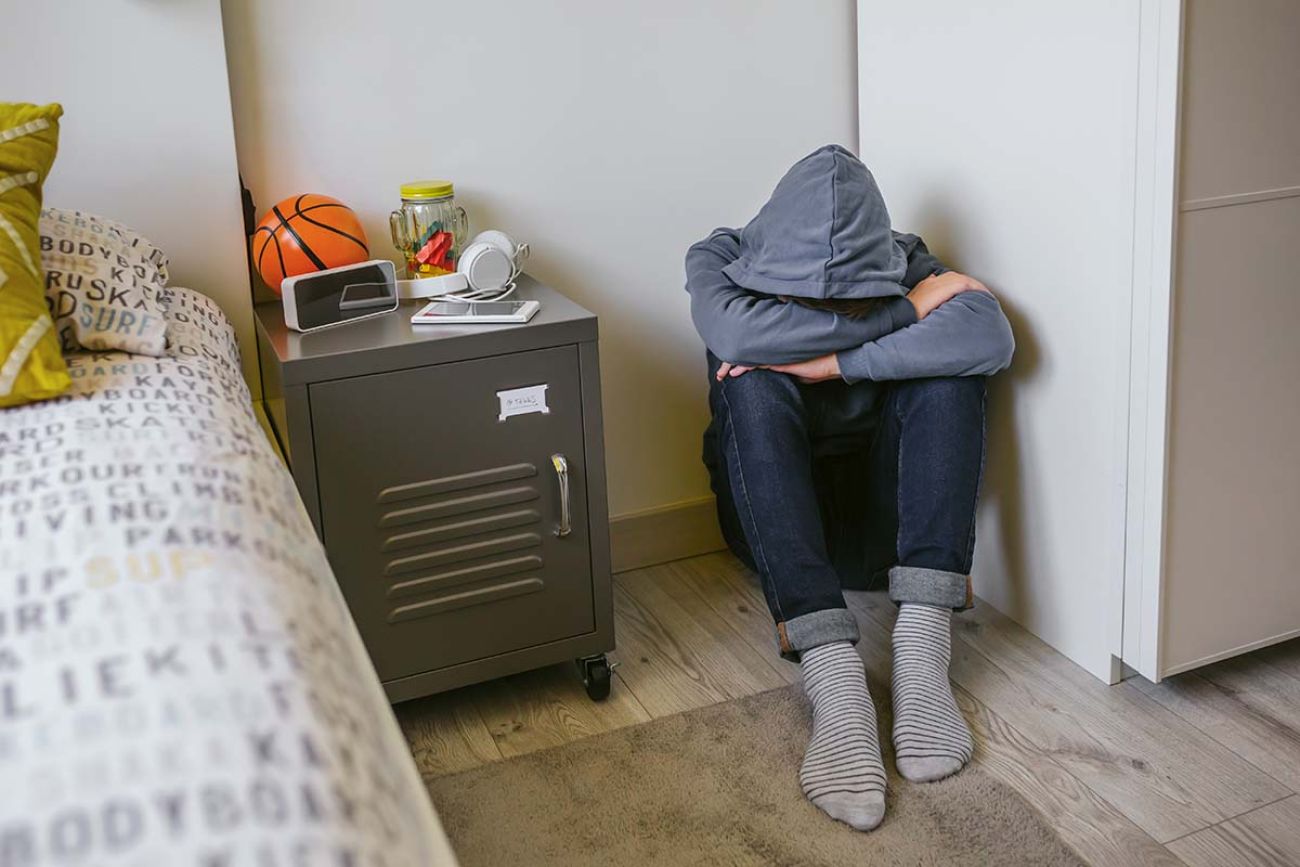Michigan youth in mental health crisis: Could more screening help?

- Experts say the COVID-19 pandemic has worsened mental health issues for Michigan youth
- Suicide tied for the leading cause of death in Michigan youth aged 10 to 14
- U.S. Preventive Services Task Force, in guidance issued last fall, says for the first time providers should screen for anxiety disorders in children
In a troubling time for Michigan children, a pediatrician could be the first health care professional to pick up signs of mental health distress in a child.
And, for the first time a national advisory panel of experts in primary care and prevention recommends that all children aged 8 to 18 be screened for anxiety disorders.
A Grand Rapids pediatrician and hospital behavioral health specialist thinks it could be a potential game changer for youth mental health in Michigan.
Related:
- ‘Staggering’ rise in overdoses, suicides for African Americans in Michigan
- Michigan sees spike in 988 mental health calls. But what happens next?
- Wake up call: Pediatric group issues guidance against childhood obesity
“This is actually a very good step toward children’s mental health,” Dr. Subodh Jain, an adolescent psychiatrist and division chief of the behavioral health department at Corewell Health Helen DeVos Children’s Hospital, told Bridge Michigan.
“Anxiety disorder is extremely common, but it is extremely under-diagnosed,” he said.
That could shift, in the wake of recommendations in October of the U.S. Preventive Services Task Force that all children and adolescents from age 8 to 18 be screened for anxiety, regardless of whether they have symptoms. The recommendation followed a review that evaluated the potential harms and benefits of screening.
But even with that, it’s unclear how many children diagnosed with anxiety disorder or other mental health issues will get needed treatment, given findings of a 2019 University of Michigan study that found about 100,000 Michigan children were diagnosed with depression, anxiety, and attention deficit hyperactivity disorder. But of those, it found that about 40,000 were not getting treatment. Researchers attributed that to lack of affordability, access to care and stigma about mental health.
With the onset of the COVID-19 pandemic, it’s become clear that Michigan children are under increasing emotional strain brought on by school closings, social isolation, even death among family members from COVID-19.
In Michigan, death by suicide is tied with unintentional injury for the leading cause of death for 10-14 year olds, according to the 2022 annual report of the Michigan Suicide Prevention Commission. Nationally, suicide remains the second leading cause of death for children 10-14 and those 15-24 years of age.
The percentage of children in Michigan diagnosed with anxiety by a health care provider climbed by 13.4 percent from 2016 to 2020.
Nationally, the Centers for Disease Control and Prevention (CDC) reports that mental health-related ER visits in adolescents aged 12 to 17 surged by 31 percent in 2020, the first year of the pandemic. The pandemic has been especially taxing among young girls, with ER visits involving adolescent girls attempting suicide climbing 51 percent in the early months of 2021 compared to the same period in 2019.
Leading pediatric associations including the American Academy of Pediatrics last year declared a national emergency in children’s mental health, citing the pandemic’s ongoing toll.
Red flags for childhood stress are also evident in schools.
Since the start of the pandemic, 70 percent of U.S. public schools reported a rise in K-12 students seeking mental health services at school, according to the National Center for Education Statistics.
But just 56 percent of schools said they could effectively provide services to students in need, including one-on-one counseling, case management, and referrals. Schools reported not having enough professional mental health staff members, access to licensed mental health professionals, and funding.
In Michigan, a shortage of school counselors has plagued the K-12 system for years, as schools struggle for funds or to find qualified mental health professionals to hire.
According to the American School Counselor Association, Michigan had the third worst ratio of students to counselors in the 2021-2022 school year, with 615 students for each counselor. The association recommends a ratio of 250 students per counselor.
Of approximately 900 public school districts and public academies in Michigan, about 40 percent had no counselor in the 2020-2021, according to data collected by the Michigan School Counselor Association (MSCA).
Tony Warren, a past president of the MSCA, said these shortages can exact a toll on students as they try to navigate trying times.
“This is something that has a major impact, especially for students of color,” said Warren, an education and counseling consultant for the Calhoun Intermediate School District east of Battle Creek.
“They are more likely to need the services of a counselor, balancing what they may be facing — college applications, managing mental health stressors, parent challenges. So not only does it impact all students, but it impacts students of color and first generation college students in a different way.”
Kevin Fischer, executive director of the Michigan chapter of the National Alliance on Mental Illness (NAMI), the nation's largest grassroots mental health organization, told Bridge he considers the new screening recommendations for anxiety overdue.
“I’ve been saying for years that primary care doctors can be the frontline for identifying any patient who may have a behavioral health need. The earlier we can diagnose and provide treatment, the better the outcome and the less the cost is likely to be.”
Most chronic mental health conditions surface in childhood or adolescence, though it may be years until their disorders are identified and they receive treatment. That’s because children typically don’t seek help on their own, while teachers and parents may not be equipped to identify mental health problems.
And anxiety is the most common mental health problem affecting children and adolescents, as the CDC estimates that 9.4 percent of U.S. children had diagnosed anxiety from 2016 to 2019, rising from 6.4 percent diagnosed with anxiety in 2011-2012.
But as Bridge has reported for years, the youth mental health treatment gap might be most keenly felt in adolescent psychiatric care, where teens in mental health crisis languish in hospitals for weeks, while nurses or administrators scramble to find beds in psychiatric centers.
In the 300-mile wide Upper Peninsula, there’s not a single inpatient bed for youth psychiatric care, on top of a scarcity of a range of mental health providers in rural communities across the region.
Staffing shortages have helped shrink the number of residential spaces available to children and adolescents in a severe mental-health crisis in Michigan’s foster and juvenile justice systems.
What was at one point 800 slots for young people in distress shrunk to fewer than 500 spaces in 2022, largely due to the lack of workers.
State health officials embarked in 2022 on an effort to expand treatment capacity by offering financial incentives to dozens of residential treatment facilities that contract with the Michigan Department of Health and Human Services.
Given the unmet mental health needs of many Michigan children, Jade Burns, Ph.D., an assistant professor in the department of health behavior and biological sciences at the University of Michigan, called the new anxiety screening recommendations for children and adolescents “spot on.”
Burns also said there’s reason to believe the pandemic has been especially hard on the emotional stability of Black youth. Burns is a researcher on youth mental health issues.
“Black youth are at higher risk for suicide than their white counterparts because of the elements they live with. The stigma about mental health, the barriers to care, are major factors for them not having access to resources they need.”
Indeed, according to the American Academy of Child and Adolescent Psychiatry, national suicide rates for Black youth aged 10 to 19 have climbed faster than any other racial or ethnic group in the past two decades. Black youth early in adolescence are twice as likely to die by suicide compared to their white counterparts in the same age group .
The academy notes: “Data does show us that community violence, socioeconomic stress, perceived discrimination, stigma, and interpersonal and family conflict are greater predictors for suicide in Black children and adolescents than in their white peers.”
But anxiety is also widespread among adults, as the CDC reports that nearly 12 percent of U.S. adults aged 18 and over have regular feelings of worry, nervousness, or anxiety.
Dr. Erin McNeely, an internal medicine health physician with Corewell Health in suburban Grand Rapids, has been screening her adult patients for anxiety for several years. When they screen positive for anxiety through a series of questions, she refers them to counseling and treatment where appropriate.
“Some of them do well with medication, some don’t,” she said. “Some need therapy, others need combination care. We know with COVID and all the things happening in the world, the economy, the shootings, our anxiety has increased.”
Given the stress facing many of her patients, McNeely said it only makes sense for physicians like herself to serve a frontline role in the mental health diagnostic network.
“This is really important for our patients,” she told Bridge.
“In primary care, we are right at the front of it. We’re seeing these patients at the start of all their health needs before they get into a specialist.”
See what new members are saying about why they donated to Bridge Michigan:
- “In order for this information to be accurate and unbiased it must be underwritten by its readers, not by special interests.” - Larry S.
- “Not many other media sources report on the topics Bridge does.” - Susan B.
- “Your journalism is outstanding and rare these days.” - Mark S.
If you want to ensure the future of nonpartisan, nonprofit Michigan journalism, please become a member today. You, too, will be asked why you donated and maybe we'll feature your quote next time!





